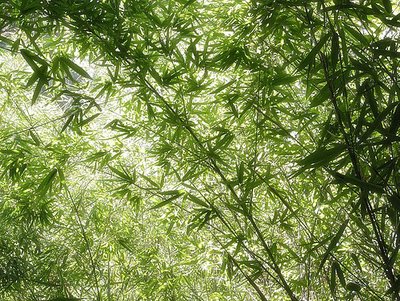I’m often very amazed by many things. Maybe this time round, I shall briefly talk about bamboo (竹).
Have we ever walked into a bamboo forest? I know it’s really unimaginable in the local context. But I would still believe we have caught a glimpse of it some where, especially on panda-related documentaries (panda loves to eat bamboo leaves mah), or Guan-Yin-related serials or movies (Guan-Yin stays at 紫竹林 mah). Right?
Actually if we are observant enough we can still see some small clusters of bamboo trees growing along our local forest trails or kampong sites. Not that impressive, but we can always use our brain power to “extrapolate” and imagine how a huge bamboo forest my look like.
Just looking at bamboo trees can give me quite a soothing effect.
The Leaves..
The elongated shape of the leaves with “veins” running along almost in parallel of the edge is rather appealing to me. No no no, I’m not talking about the leaves as individual leaf, I like it best to see many of the leaves overlapping each other in the most natural form. They “cover” each other, with the longer ones somewhat “shyly” protruding from underside the ones on top.
The Trunk..
We know how hard or strong it can be. But does it occur to you that the trunk is empty within? In many Chinese writings, this is described as the nature way of teaching us to be 【虚心】 , the need to be humble so as to be strong(er). Think about it.
It may also be noted that the entire trunk of the bamboo tree is naturally divided into many sections. The parts dividing the trunk into different sections are particularly hard. We call that 【竹节】. This is perhaps again the nature way of teaching us
作为一个人一定要有【节】。
节:节操、节义。
有【节】才能象竹一般生得壮、长得高、看得远。
No wonder in many Chinese paintings, we can see bamboo drawn either as the main subject or as a distinctive background. It is just so representative – representing the many good values.
There is another aspect of bamboo trees which can be easily missed. We may have seen bamboo trees before, but have we “heard” them?
When the wind blows, the leaves being hard enough and close enough, will brush by each other to produce a neat natural whistling tune. Pretty lovely. And when the wind stops, the tune will die down immediately too. There is this popular saying :
风来疏竹,风过而竹不留声;
雁度寒潭,雁去而潭不留影。
故君子事来而心始现,事去而心随空。--《菜根谭》
The last line summaries really well, I think. Just how much have we learnt (just by observing bamboo)? Plenty! :)


No comments:
Post a Comment